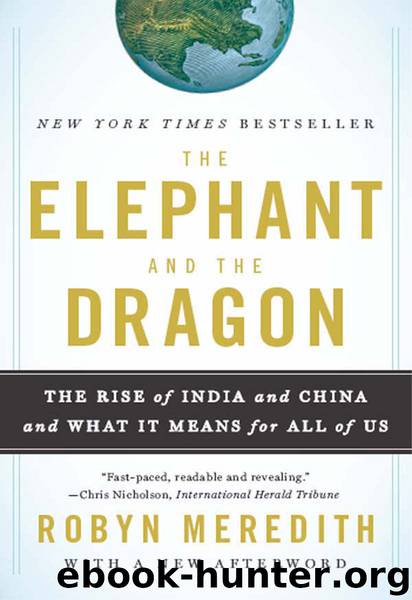The Elephant and the Dragon by Robyn Meredith

Author:Robyn Meredith
Language: eng
Format: epub
Publisher: W. W. Norton & Company
Published: 2007-09-27T04:00:00+00:00
WHILE INDIAN UNIVERSITY GRADUATES line up for jobs that can propel them into the newly vibrant middle class, for India’s rural and urban poor, change has been interminably delayed. Expectations, like incomes, are rising across India, and not just for those working in call centers. Even as the New India cohort thrives, much of the rest of India is making much slower gains or even being left behind, creating social and political tensions that cloud India’s impressive strides forward. The lowest-paid workers in the offshoring industry—those working in call centers—earn median wages of $275 a month.19 But most Indians still earn less than $60 a month, or just $2 a day.
Change has come in small increments to India’s villages, where 70 percent of the population lives. Many villages now have a communal television, and those who can afford a computer often have dial-up Internet access, which is helping raise awareness of the world beyond. But time has stood still on many more pressing, day-to-day problems. Many villages still lack running water, electricity, and reliable access to medical care. In 2006, in an effort to cut down on diseases like diarrhea, the government embarked on a high-profile campaign to persuade Indian villagers to install outhouses and stop using nearby fields as toilets. This is the very same hygiene mantra Gandhi championed seventy years earlier.
A village in eastern India called Idulbera shows that even villages that have made big gains have not managed to lift residents into the middle class. Negi Singh Sadar, seventy, is the leader of Idulbera, where children tend cows and goats while adults work the fields or travel over bumpy dirt roads to the nearby city of Jamshedpur to look for work. Entire families live in one-room, dirt-floored homes, and the sight of a car or motorcycle is a rarity, despite the eight-mile distance to the nearest city. With a $6,500 donation from charities and a $4,000 contribution from villagers, his village changed its planting practices and tripled village incomes in five years.20 “We had one crop a year—rice,” said Mr. Sadar, a four-foot-tall man with gray hair, a quick smile, and pride in the gains his village of a few hundred people has experienced since 1997, when it managed to buy a communal water pump. Villagers can rent the pump for thirty cents an hour plus the cost of the diesel it uses, enabling them to water their fields and squeeze additional plantings into the growing season. Now, in addition to rice, the village grows green beans, okra, and eggplants to sell at Jamshedpur’s market. Even more profitably, villagers grow bright orange marigolds, make them into garlands, and sell them—two for a quarter—to worshipers in Hindu temples in nearby Jamshedpur. In a land where only 70 percent of children nationwide are vaccinated,21 all the children in Idulbera have received immunizations, Mr. Sadar said. He is already planning for their future: he used some of the village profits to plant a stand of teak trees, which won’t be ready to harvest until the village’s children are grown up.
Download
This site does not store any files on its server. We only index and link to content provided by other sites. Please contact the content providers to delete copyright contents if any and email us, we'll remove relevant links or contents immediately.
The Meaning of the Library by unknow(2391)
Six Billion Shoppers by Porter Erisman(2229)
Why Nations Fail: The Origins of Power, Prosperity, and Poverty by Daron Acemoglu & James Robinson(2180)
No Time to Say Goodbye(1999)
Red Notice by Bill Browder(1935)
The Economist [T6, 22 Thg9 2017] by The Economist(1845)
Currency Trading For Dummies by Brian Dolan(1793)
Thank You for Being Late by Thomas L. Friedman(1680)
Bitcoin: The Ultimate Guide to the World of Bitcoin, Bitcoin Mining, Bitcoin Investing, Blockchain Technology, Cryptocurrency (2nd Edition) by Ikuya Takashima(1615)
Amazon FBA: Amazon FBA Blackbook: Everything You Need To Know to Start Your Amazon Business Empire (Amazon Empire, FBA Mastery) by John Fisher(1496)
Coffee: From Bean to Barista by Robert W. Thurston(1422)
The Future Is Asian by Parag Khanna(1402)
The Great Economists by Linda Yueh(1394)
Capitalism Without Capital: The Rise of the Intangible Economy by Jonathan Haskel(1342)
Pocket World in Figures 2018 by The Economist(1329)
How Money Got Free: Bitcoin and the Fight for the Future of Finance by Brian Patrick Eha(1322)
Grave New World by Stephen D. King(1317)
The Sex Business by Economist(1284)
Cultural Intelligence by David C. Thomas(1204)
